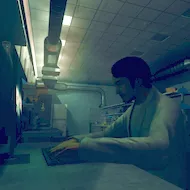

Don’t Look Back is a minimalist action-platform game that combines precision movement with psychological tension. The objective seems straightforward—cross from one side of the screen to the other—but each step challenges players to maintain composure and accuracy. The design strips away distractions, focusing entirely on movement, timing, and decision-making. The journey becomes both a test of skill and an exploration of emotional endurance.
At its core, Don’t Look Back demands full attention to timing and rhythm. Each section requires players to calculate jumps, anticipate obstacles, and adapt quickly to new challenges. Simple controls disguise the depth of coordination required to progress successfully through the game’s linear but unforgiving layout.
Mastery comes not from memorization alone but from recognizing rhythm and maintaining patience. Each retry builds familiarity, turning frustration into control.
The atmosphere in Don’t Look Back uses minimal visuals and sparse audio to create tension. Shadows, repetition, and emptiness replace typical graphical richness, amplifying the sensation of isolation. This stark presentation directs focus toward movement and timing while reinforcing the underlying emotional narrative of loss and persistence.
Through these elements, Don’t Look Back establishes an immersive experience that feels personal despite its simplicity. The environment mirrors the mental challenge of continuing forward despite setbacks.
The game progresses through a sequence of increasingly difficult rooms. Each room introduces new dangers or changes in rhythm, forcing constant adaptation. Players must learn to read environments, commit to timing, and remain aware of the invisible patterns guiding progress.
This structure creates a balanced rhythm between frustration and satisfaction. Repetition is part of the intended rhythm, emphasizing growth through resilience.
Don’t Look Back rewards players who treat repetition as discovery rather than punishment. Each playthrough reveals subtleties in pacing and control, allowing greater precision and insight. The straightforward objective conceals a deeper challenge: learning patience, rhythm, and focus. In its minimal design, the game invites introspection about perseverance and attention.
Through its simplicity and relentless difficulty, Don’t Look Back proves that meaningful interaction can emerge from the smallest of movements and the quietest of moments.